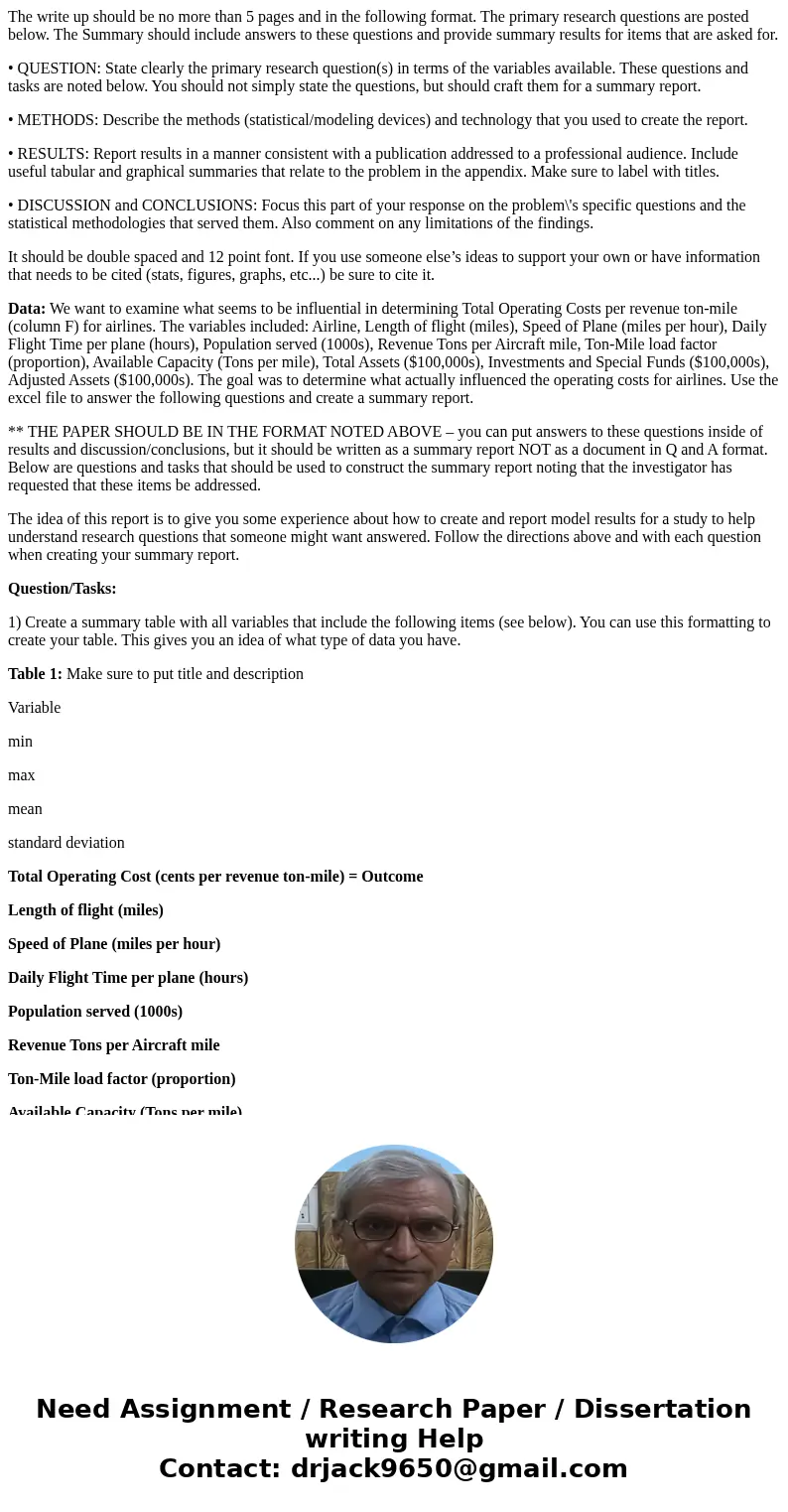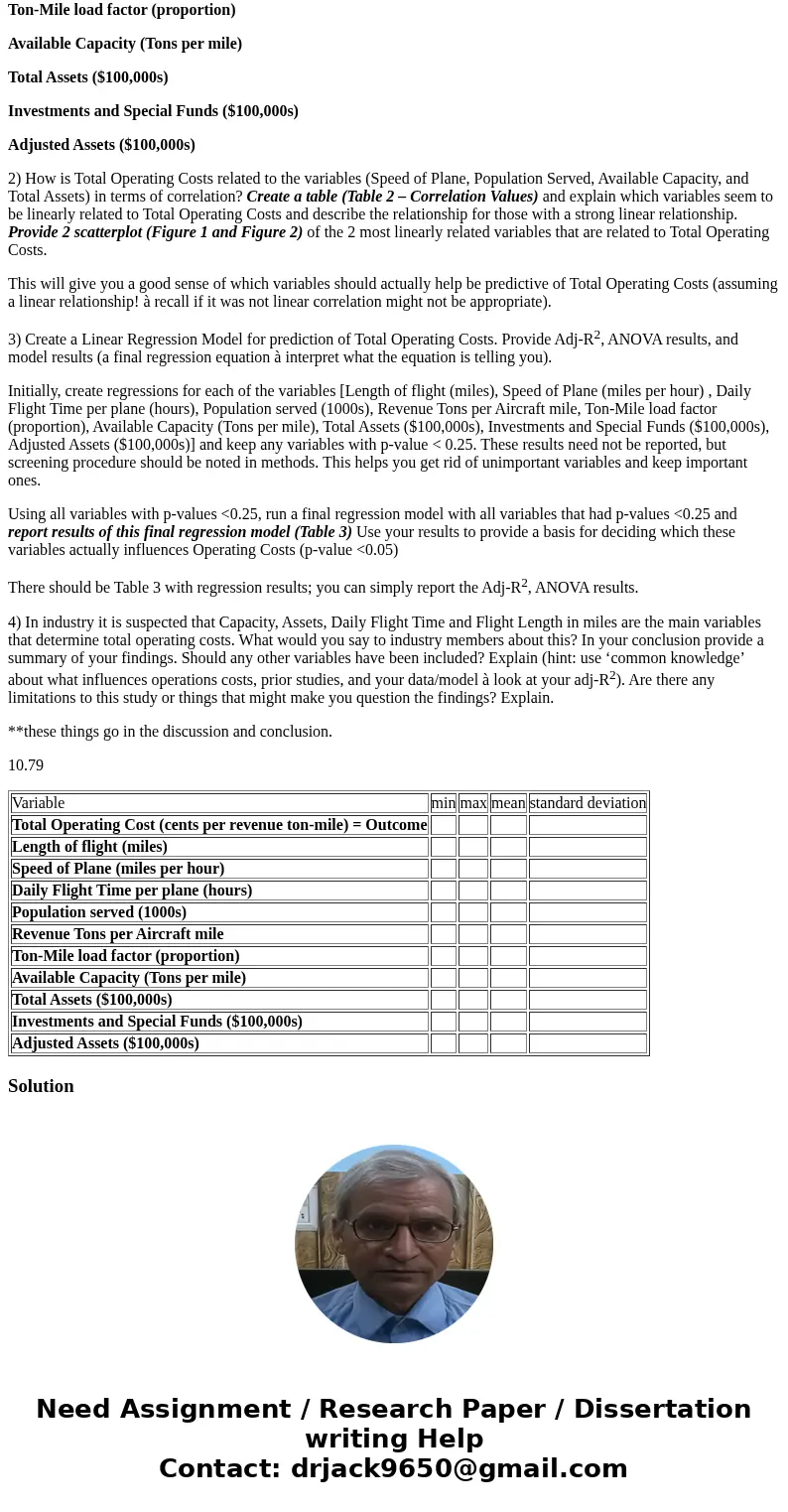The write up should be no more than 5 pages and in the follo
The write up should be no more than 5 pages and in the following format. The primary research questions are posted below. The Summary should include answers to these questions and provide summary results for items that are asked for.
• QUESTION: State clearly the primary research question(s) in terms of the variables available. These questions and tasks are noted below. You should not simply state the questions, but should craft them for a summary report.
• METHODS: Describe the methods (statistical/modeling devices) and technology that you used to create the report.
• RESULTS: Report results in a manner consistent with a publication addressed to a professional audience. Include useful tabular and graphical summaries that relate to the problem in the appendix. Make sure to label with titles.
• DISCUSSION and CONCLUSIONS: Focus this part of your response on the problem\'s specific questions and the statistical methodologies that served them. Also comment on any limitations of the findings.
It should be double spaced and 12 point font. If you use someone else’s ideas to support your own or have information that needs to be cited (stats, figures, graphs, etc...) be sure to cite it.
Data: We want to examine what seems to be influential in determining Total Operating Costs per revenue ton-mile (column F) for airlines. The variables included: Airline, Length of flight (miles), Speed of Plane (miles per hour), Daily Flight Time per plane (hours), Population served (1000s), Revenue Tons per Aircraft mile, Ton-Mile load factor (proportion), Available Capacity (Tons per mile), Total Assets ($100,000s), Investments and Special Funds ($100,000s), Adjusted Assets ($100,000s). The goal was to determine what actually influenced the operating costs for airlines. Use the excel file to answer the following questions and create a summary report.
** THE PAPER SHOULD BE IN THE FORMAT NOTED ABOVE – you can put answers to these questions inside of results and discussion/conclusions, but it should be written as a summary report NOT as a document in Q and A format. Below are questions and tasks that should be used to construct the summary report noting that the investigator has requested that these items be addressed.
The idea of this report is to give you some experience about how to create and report model results for a study to help understand research questions that someone might want answered. Follow the directions above and with each question when creating your summary report.
Question/Tasks:
1) Create a summary table with all variables that include the following items (see below). You can use this formatting to create your table. This gives you an idea of what type of data you have.
Table 1: Make sure to put title and description
Variable
min
max
mean
standard deviation
Total Operating Cost (cents per revenue ton-mile) = Outcome
Length of flight (miles)
Speed of Plane (miles per hour)
Daily Flight Time per plane (hours)
Population served (1000s)
Revenue Tons per Aircraft mile
Ton-Mile load factor (proportion)
Available Capacity (Tons per mile)
Total Assets ($100,000s)
Investments and Special Funds ($100,000s)
Adjusted Assets ($100,000s)
2) How is Total Operating Costs related to the variables (Speed of Plane, Population Served, Available Capacity, and Total Assets) in terms of correlation? Create a table (Table 2 – Correlation Values) and explain which variables seem to be linearly related to Total Operating Costs and describe the relationship for those with a strong linear relationship. Provide 2 scatterplot (Figure 1 and Figure 2) of the 2 most linearly related variables that are related to Total Operating Costs.
This will give you a good sense of which variables should actually help be predictive of Total Operating Costs (assuming a linear relationship! à recall if it was not linear correlation might not be appropriate).
3) Create a Linear Regression Model for prediction of Total Operating Costs. Provide Adj-R2, ANOVA results, and model results (a final regression equation à interpret what the equation is telling you).
Initially, create regressions for each of the variables [Length of flight (miles), Speed of Plane (miles per hour) , Daily Flight Time per plane (hours), Population served (1000s), Revenue Tons per Aircraft mile, Ton-Mile load factor (proportion), Available Capacity (Tons per mile), Total Assets ($100,000s), Investments and Special Funds ($100,000s), Adjusted Assets ($100,000s)] and keep any variables with p-value < 0.25. These results need not be reported, but screening procedure should be noted in methods. This helps you get rid of unimportant variables and keep important ones.
Using all variables with p-values <0.25, run a final regression model with all variables that had p-values <0.25 and report results of this final regression model (Table 3) Use your results to provide a basis for deciding which these variables actually influences Operating Costs (p-value <0.05)
There should be Table 3 with regression results; you can simply report the Adj-R2, ANOVA results.
4) In industry it is suspected that Capacity, Assets, Daily Flight Time and Flight Length in miles are the main variables that determine total operating costs. What would you say to industry members about this? In your conclusion provide a summary of your findings. Should any other variables have been included? Explain (hint: use ‘common knowledge’ about what influences operations costs, prior studies, and your data/model à look at your adj-R2). Are there any limitations to this study or things that might make you question the findings? Explain.
**these things go in the discussion and conclusion.
10.79
| Variable | min | max | mean | standard deviation |
| Total Operating Cost (cents per revenue ton-mile) = Outcome | ||||
| Length of flight (miles) | ||||
| Speed of Plane (miles per hour) | ||||
| Daily Flight Time per plane (hours) | ||||
| Population served (1000s) | ||||
| Revenue Tons per Aircraft mile | ||||
| Ton-Mile load factor (proportion) | ||||
| Available Capacity (Tons per mile) | ||||
| Total Assets ($100,000s) | ||||
| Investments and Special Funds ($100,000s) | ||||
| Adjusted Assets ($100,000s) |
Solution


 Homework Sourse
Homework Sourse